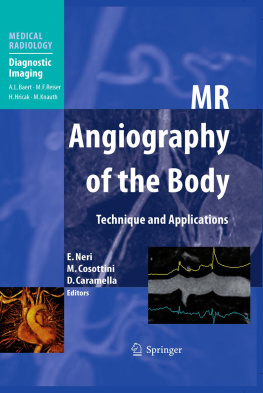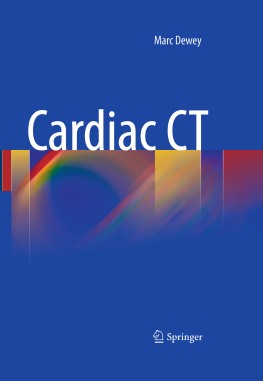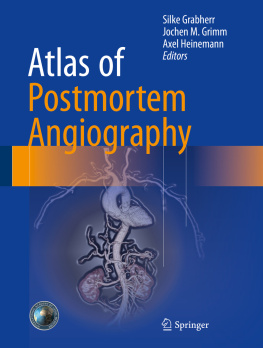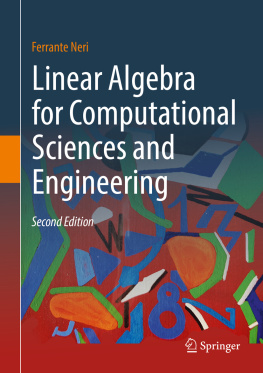E. Neri , M. Cosottini and D. Caramella (eds.) Diagnostic Imaging MR Angiography of the Body 10.1007/978-3-540-79717-3_1 Springer-Verlag Berlin Heidelberg 2010
1. Flow-Based MRA
Abstract
MR imaging is particularly suited to depict vessels and this can be obtained using sequences that highlight flow. In the era of nephrogenic sistemic fibrosis these unenhanced sequences are used more frequently than in the past.
These sequences are based on three principles: time of flight, phase contrast, and fresh blood acquisitions. The physical principles of these acquisitions are explained in order to understand the basis of MR angiography.
In the evaluation of vessel lumen, MR sequences can be applied in order to detect flow. These sequences are based mainly on three principles: (a) using the inflow into the slab of fresh spins, which are not subjected to all the radiofrequency pulses, unlike the stationary tissue: time-of-flight phenomenon; (b) detecting the phase changes of moving spins subjected to a gradient: phase contrast; (c) optimizing an ultrafast spin echo or gradient echo sequence, in order to obtain bright signal from blood due to its T2 properties.
In all three techniques, the signal and resulting image are produced by physiological flow, and these methods will be degraded by artifacts in case of complex or turbulent flows [].
In general, the MR angiography techniques use sequences derived from T1-weighted gradient echo sequences. In fact vessels generally appear as hyposignals in spin echo sequences because of the outflow effect. The spins in the blood are excited during the slice selection pulse. At time TE/2, the flowing spins move out of the slice and are not subjected to the 180 pulse: therefore they do not give any signal in the original voxel (signal void). When the flow is turbulent and not laminar, some spins are back in the original voxel at the time of the echo refocusing and give some signal (artifact) [].
1.1 Time of Flight (TOF) MR Angiography
In time-of-flight MR angiography [], gradient-echo sequences are optimized to favor the vascular signal over that of the surrounding tissues by saturating the stationary tissue signal with very short TR (TR largely inferior to the tissues T1). The longitudinal magnetization of these tissues does not have time to regrow after some 90 pulses and after their signal weakens. The flowing spins coming into the slice volume have not been saturated yet, giving high signal intensity. The strength of the vascular signal is proportional to the flow velocity (faster flow gives higher signal intensity) and depends on the length and orientation of the vessel (the vascular signal will be higher if the slice is perpendicular to the axis of the vessel) due to shorter travel of the spins into the slice volume. In the case of a long vessel tract traveling into the slice, flowing spins will receive many saturating pulses, lowering the signal they can return from them. The shorter the TR and the higher the flip angle, the stronger is the stationary tissues suppression, but slow flowing spins can also be suppressed. A longer TE causes dephasing of the flowing spins, lowering vessel signal intensity. An increased slice thickness also causes a longer travel of the flowing spins into the imaging plane with some degree of vessel signal loss due to the progressive saturation of the spins.
The main limitations of time-of-flight MRA are signal loss linked to spin dephasing when the flow is complex or turbulent (stenosis), when the flow is too slow or oriented parallel to the slice plane and poor signal suppression of the stationary tissues when substances with very short T1 relaxation time are present (fat, blood degradation products) [].
To selectively visualize arterial or venous flow, presaturation bands can be applied upstream to the selected slice (arterial suppression to detect venous flow only) or dow nstream to the selected slice (venous suppression).
Time of Flight MR angiography can be obtained in 2D or 3D mode.
In 2D acquisition, single thin slices are obtained in sequential order while in 3D acquisition, a thicker slice is excited and many single partitions are reconstructed from this thick slab by different phase encoding steps. The main advantage of the 2D technique is better sensitivity to slow flows (shorter travel of the moving spins into the slice), with the possibility of using higher flip angles (giving better stationary tissue saturation). The main drawback of 2D acquisition is poor through plane spatial resolution due to the thickness of the slices.
Contrary to the 2D TOF and 3D TOF, volumetric imaging gives good spatial resolution in all spatial directions, with a better signal-to-noise ratio, but the flowing spins travel through a thick volume, with progressive signal loss due to in-plane saturation. The slowest flows are more sensitive to this artifact. Flow saturation can be reduced by (a) dividing 3D acquisition into thinner slabs (MOTSA: multiple overlapping thin slab acquisition), (b) by using a variable excitation angle that is lower as the flow enters the volume and higher as it leaves the volume (TONE: tilted optimized nonsaturating excitation), thus compensating relaxation of short T1 tissues.
1.2 Phase Contrast (PC) MR Angiography
Phase contrast angiography relies on dephasing the moving spins submitted to a bipolar gradient in gradient echo acquisitions. In the presence of a bipolar gradient of a given intensity and time, the moving spins will dephase in proportion to their velocity while stationary spins will be dephased and rephased by the opposite gradients, returning to their original status. So the flow velocity is proportional to the phase shift and the stationary tissues phase shift is null.
Similar to spatial encoding in the phase direction, the possible phase values range from to +. Beyond this range of values, aliasing occurs, causing wrong velocity encoding [].
The encoding gradient characteristics are thus defined in order to encode flows within a certain velocity range from venc to +venc; this range has to be determined by the user before acquiring the data. Any velocity outside this range will be poorly encoded (similar to what happens in pulsed and color Doppler with pulse repetition frequency-PRF). The bipolar gradients are applied in a particular axis ( x, y , or z ) and the dephasing of the spins moving along the gradient axis is proportionate to their velocity, gradient intensity and the application time of a gradient lobe. Magnetic field heterogeneities can cause stationary spin dephasing. To compensate for these dephasings, a second acquisition is obtained, reversing the order of the encoding gradient lobes, and subtracting the two acquisitions: the moving spins will cumulate dephasings in the opposite direction, while dephas-ing of stationary spins due to field heterogeneities will be identical for both acquisitions, disappearing in subtraction.
To depict the movements in all the directions of space, the acquisitions are repeated with flow-encoding gradients in each of the three spatial directions. An additional acquisition with no flow-encoding gradient will serve as a reference.
The images acquired with flow-encoding gradient are summed to depict flow in all directions and subtracted from the reference image without encoding gradient. With this subtraction only vessels are depicted, as well as those that run parallel to the imaging plane.












